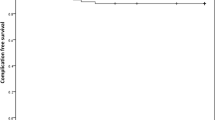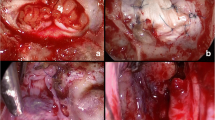Abstract
Objective
We assessed the outcomes of various reconstructive methods for skull base defect after endoscopic endonasal approaches (EEA) depending on the degree of intraoperative cerebrospinal fluid (CSF) leaks.
Methods
Between Jan. 2008 and Sep. 2009, 122 consecutive patients underwent 124 EEA for sellar and extra-sellar lesions. Intraoperative CSF leaks were classified as grade 0, no intraoperative CSF leak; grade 1, low output; and grade 2, high-output based on the degree of CSF leakage and size of opening in the arachnoid membrane (<5 or ≥5 mm).
Results
Postoperative CSF leaks or meningitis occurred in 13 of 124 cases (10.5%). In 77 patients with grade 0, there was no postoperative CSF leak. Among 20 patients with grade 1 CSF leaks, four patients developed meningitis or postoperative CSF leak. Postoperative CSF leaks occurred in nine of 26 patients (34.6%) with grade 2 leaks. Comparison of reconstructive methods revealed that gasket-seal method provided better control of CSF leaks than free-fat graft in patients with grade 2 leaks (11.8% vs. 66.7%, p = 0.028). However, in grades 0 and 1, we found no difference among the various reconstructive methods.
Conclusion
The selection of reconstructive methods for skull base defects should be determined by the degree of CSF leaks. Although grade 0 or 1 leak requires relatively conservative management such as simple closure or free-tissue grafting, a more aggressive reconstructive technique is required to prevent postoperative complication in grade 2 CSF leak.




Similar content being viewed by others
References
Cappabianca P, Cavallo LM, Colao A, Del Basso De Caro M, Esposito F, Cirillo S, Lombardi G, de Divitiis E (2002) Endoscopic endonasal transsphenoidal approach: outcome analysis of 100 consecutive procedures. Minim Invasive Neurosurg 45:193–200
Cappabianca P, Esposito F, Esposito I, Cavallo LM, Leone CA (2009) Use of a thrombin-gelatin haemostatic matrix in endoscopic endonasal extended approaches: technical note. Acta Neurochir (Wien) 151:69–77, discussion 77
Cavallo LM, Messina A, Esposito F, de Divitiis O, Dal Fabbro M, de Divitiis E, Cappabianca P (2007) Skull base reconstruction in the extended endoscopic transsphenoidal approach for suprasellar lesions. J Neurosurg 107:713–720
Cavallo LM, Messina A, Gardner P, Esposito F, Kassam AB, Cappabianca P, de Divitiis E, Tschabitscher M (2005) Extended endoscopic endonasal approach to the pterygopalatine fossa: anatomical study and clinical considerations. Neurosurg Focus 19:E5
Cavallo LM, Prevedello DM, Solari D, Gardner PA, Esposito F, Snyderman CH, Carrau RL, Kassam AB, Cappabianca P (2009) Extended endoscopic endonasal transsphenoidal approach for residual or recurrent craniopharyngiomas. J Neurosurg 111:578–589
Couldwell WT, Kan P, Weiss MH (2006) Simple closure following transsphenoidal surgery. Technical note. Neurosurg Focus 20:E11
Dusick JR, Esposito F, Kelly DF, Cohan P, DeSalles A, Becker DP, Martin NA (2005) The extended direct endonasal transsphenoidal approach for nonadenomatous suprasellar tumors. J Neurosurg 102:832–841
Dusick JR, Mattozo CA, Esposito F, Kelly DF (2006) BioGlue for prevention of postoperative cerebrospinal fluid leaks in transsphenoidal surgery: a case series. Surg Neurol 66:371–376, discussion 376
Esposito F, Dusick JR, Fatemi N, Kelly DF (2007) Graded repair of cranial base defects and cerebrospinal fluid leaks in transsphenoidal surgery. Neurosurgery 60:295–303, discussion 303-294
Fortes FS, Carrau RL, Snyderman CH, Prevedello D, Vescan A, Mintz A, Gardner P, Kassam AB (2007) The posterior pedicle inferior turbinate flap: a new vascularized flap for skull base reconstruction. Laryngoscope 117:1329–1332
Gardner P, Kassam A, Snyderman C, Mintz A, Carrau R, Moossy JJ (2008) Endoscopic endonasal suturing of dural reconstruction grafts: a novel application of the U-Clip technology. Technical note. J Neurosurg 108:395–400
Gardner PA, Kassam AB, Rothfus WE, Snyderman CH, Carrau RL (2008) Preoperative and intraoperative imaging for endoscopic endonasal approaches to the skull base. Otolaryngol Clin North Am 41:215–230, vii
Gardner PA, Kassam AB, Snyderman CH, Carrau RL, Mintz AH, Grahovac S, Stefko S (2008) Outcomes following endoscopic, expanded endonasal resection of suprasellar craniopharyngiomas: a case series. J Neurosurg 109:6–16
Gardner PA, Kassam AB, Thomas A, Snyderman CH, Carrau RL, Mintz AH, Prevedello DM (2008) Endoscopic endonasal resection of anterior cranial base meningiomas. Neurosurgery 63:36–52, discussion 52–34
Hadad G, Bassagasteguy L, Carrau RL, Mataza JC, Kassam A, Snyderman CH, Mintz A (2006) A novel reconstructive technique after endoscopic expanded endonasal approaches: vascular pedicle nasoseptal flap. Laryngoscope 116:1882–1886
Harvey RJ, Sheahan PO, Schlosser RJ (2009) Inferior turbinate pedicle flap for endoscopic skull base defect repair. Am J Rhinol Allergy 23:522–526
Kassam A, Carrau RL, Snyderman CH, Gardner P, Mintz A (2005) Evolution of reconstructive techniques following endoscopic expanded endonasal approaches. Neurosurg Focus 19:E8
Kassam A, Thomas AJ, Snyderman C, Carrau R, Gardner P, Mintz A, Kanaan H, Horowitz M, Pollack IF (2007) Fully endoscopic expanded endonasal approach treating skull base lesions in pediatric patients. J Neurosurg 106:75–86
Kassam AB, Gardner P, Snyderman C, Mintz A, Carrau R (2005) Expanded endonasal approach: fully endoscopic, completely transnasal approach to the middle third of the clivus, petrous bone, middle cranial fossa, and infratemporal fossa. Neurosurg Focus 19:E6
Kassam AB, Gardner PA, Mintz A, Snyderman CH, Carrau RL, Horowitz M (2007) Endoscopic endonasal clipping of an unsecured superior hypophyseal artery aneurysm. Technical note. J Neurosurg 107:1047–1052
Kassam AB, Snyderman C, Gardner P, Carrau R, Spiro R (2005) The expanded endonasal approach: a fully endoscopic transnasal approach and resection of the odontoid process: technical case report. Neurosurgery 57:E213, discussion E213
Kassam AB, Thomas A, Carrau RL, Snyderman CH, Vescan A, Prevedello D, Mintz A, Gardner P (2008) Endoscopic reconstruction of the cranial base using a pedicled nasoseptal flap. Neurosurgery 63:ONS44-52, discussion ONS52-43
Kelly DF, Oskouian RJ, Fineman I (2001) Collagen sponge repair of small cerebrospinal fluid leaks obviates tissue grafts and cerebrospinal fluid diversion after pituitary surgery. Neurosurgery 49:885–889, discussion 889–890
Leng LZ, Brown S, Anand VK, Schwartz TH (2008) “Gasket-seal” watertight closure in minimal-access endoscopic cranial base surgery. Neurosurgery 62:ONSE342–343, discussion ONSE343
Pinheiro-Neto CD, Prevedello DM, Carrau RL, Snyderman CH, Mintz A, Gardner P, Kassam A (2007) Improving the design of the pedicled nasoseptal flap for skull base reconstruction: a radioanatomic study. Laryngoscope 117:1560–1569
Prevedello DM, Thomas A, Gardner P, Snyderman CH, Carrau RL, Kassam AB (2007) Endoscopic endonasal resection of a synchronous pituitary adenoma and a tuberculum sellae meningioma: technical case report. Neurosurgery 60:E401, discussion E401
Shah RN, Surowitz JB, Patel MR, Huang BY, Snyderman CH, Carrau RL, Kassam AB, Germanwala AV, Zanation AM (2009) Endoscopic pedicled nasoseptal flap reconstruction for pediatric skull base defects. Laryngoscope 119:1067–1075
Snyderman C, Kassam A, Carrau R, Mintz A, Gardner P, Prevedello DM (2007) Acquisition of surgical skills for endonasal skull base surgery: a training program. Laryngoscope 117:699–705
Snyderman CH, Carrau RL, Kassam AB, Zanation A, Prevedello D, Gardner P, Mintz A (2008) Endoscopic skull base surgery: principles of endonasal oncological surgery. J Surg Oncol 97:658–664
Snyderman CH, Janecka IP, Sekhar LN, Sen CN, Eibling DE (1990) Anterior cranial base reconstruction: role of galeal and pericranial flaps. Laryngoscope 100:607–614
Snyderman CH, Kassam AB, Carrau R, Mintz A (2007) Endoscopic reconstruction of cranial base defects following endonasal skull base surgery. Skull Base 17:73–78
Tabaee A, Anand VK, Brown SM, Lin JW, Schwartz TH (2007) Algorithm for reconstruction after endoscopic pituitary and skull base surgery. Laryngoscope 117:1133–1137
Zanation AM, Carrau RL, Snyderman CH, Germanwala AV, Gardner PA, Prevedello DM, Kassam AB (2009) Nasoseptal flap reconstruction of high flow intraoperative cerebral spinal fluid leaks during endoscopic skull base surgery. Am J Rhinol Allergy 23:518–521
Acknowledgment
This study was partially supported by a grant of the Korea Healthcare technology R&D Project, Ministry for Health & Welfare Affairs, Republic of Korea (A092255) and by the Samsung Biomedical Research Institute grant #SBRI C-B0-303-1.
Conflicts of interest
None.
Author information
Authors and Affiliations
Corresponding author
Additional information
Comment
This well-written article points out, once again, the real weak point of transsphenoidal surgery—i.e., the management of intra-postoperative CSF leak, especially when an extended approach to the skull base is performed.
Nowadays, an increasing number of neurosurgeons are evaluating the opportunity to deal with different lesions in most areas of the skull base from below, through such a surgical route, with satisfactory results either for the patients and the surgeons. The technique described suggests another excellent method to abbreviate the times of the surgical procedure, opening a new way for the reconstruction of the osteodural skull base defect, further improving patient postoperative discomfort.
Finally, we would like to highlight the importance of use of dedicated instruments: In our opinion, it cannot be apart from the surgical armamentarium of the modern neurosurgeon, already skilled or still in learning process, dealing with transsphenoidal surgery. It seems clear that a quite long learning curve is required to perform such a technical-demanding procedure routinely.
Paolo Cappabianca
Napoli, Italy
Rights and permissions
About this article
Cite this article
Kong, DS., Kim, H.Y., Kim, SH. et al. Challenging reconstructive techniques for skull base defect following endoscopic endonasal approaches. Acta Neurochir 153, 807–813 (2011). https://doi.org/10.1007/s00701-011-0941-5
Received:
Accepted:
Published:
Issue Date:
DOI: https://doi.org/10.1007/s00701-011-0941-5




